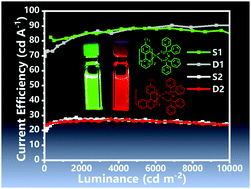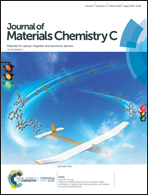Highly efficient green and red electroluminescence with an extremely low efficiency roll-off based on iridium(iii) complexes containing a bis(diphenylphorothioyl)amide ancillary ligand†
Abstract
In this study, two iridium(III) complexes named Ir(tfpmd)2(stpip) and Ir(tfpqz)2(stpip) were synthesized, in which 2-(4-(trifluoromethyl)phenyl)pyrimidine (tfpmd) or 4-(4-(trifluoromethyl)phenyl)quinazoline (tfpqz) was used as the cyclometalated ligand and bis(diphenylphorothioyl)amide (stpip) as the ancillary ligand, respectively. The Ir(tfpmd)2(stpip) complex shows green light, peaking at 501 nm with a high phosphorescence quantum efficiency of 0.83. The organic light-emitting diode (OLED) with a double-emissive-layer structure using the (tfpmd)2(stpip) complex displays good performances with a maximum luminance (Lmax) above 39 000 cd m−2, a maximum current efficiency (ηc,max) of 90.5 cd A−1, a maximum external quantum efficiency (EQEmax) of 30.8% and an extremely low efficiency roll-off. Even at the high luminance of 10 000 cd m−2, the efficiency roll-off ratio is below 5%. The Ir(tfpqz)2(stpip) complex shows red light, peaking at 624 nm, and its corresponding device with a single-emissive-layer structure also shows decent characteristics with a Lmax of 33 732 cd m−2, a ηc,max of 28.6 cd A−1, an EQEmax of 18.3% and also a very low efficiency roll-off. These results suggest that the green and red Ir(III) complexes with bis(diphenylphorothioyl)amide as the ancillary ligand have the potential for use in high-efficiency OLEDs with a low efficiency roll-off.



 Please wait while we load your content...
Please wait while we load your content...